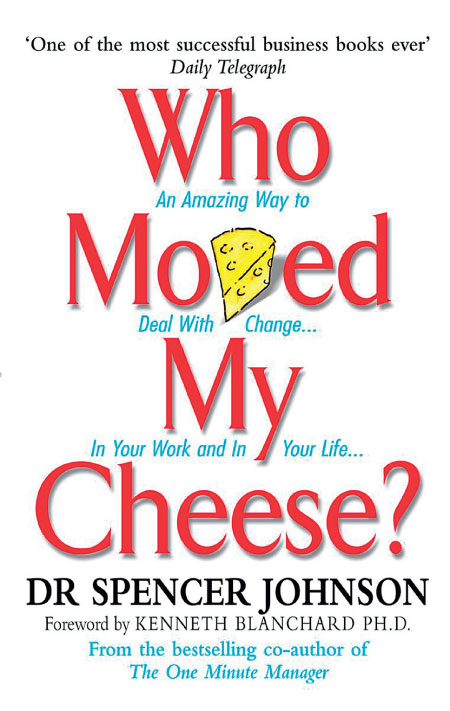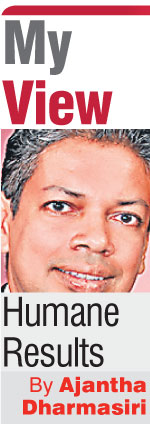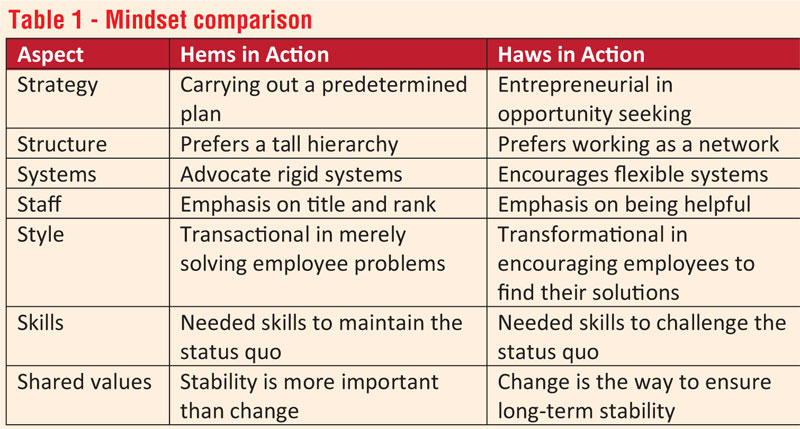Friday Jan 02, 2026
Friday Jan 02, 2026
Monday, 4 October 2021 00:00 - - {{hitsCtrl.values.hits}}
 It was refreshing to meet the workplace colleagues physically after the long lockdown. We still do not have the luxury of breathing freely without a face mask in public places. It matches well with the most-popular parable on change with cheese as a symbol. ‘Old cheese’ is no more. We must get used to the ‘new cheese’. I am referring to New York Times repeated bestseller, ‘Who moved my cheese’ by Dr. Spencer Johnson. I recall first reading it more than 20 years ago and I would have simply re-read it over 20 times. Ironically, COVID-19 has ‘moved my cheese’. Let’s reflect on the relevance.
It was refreshing to meet the workplace colleagues physically after the long lockdown. We still do not have the luxury of breathing freely without a face mask in public places. It matches well with the most-popular parable on change with cheese as a symbol. ‘Old cheese’ is no more. We must get used to the ‘new cheese’. I am referring to New York Times repeated bestseller, ‘Who moved my cheese’ by Dr. Spencer Johnson. I recall first reading it more than 20 years ago and I would have simply re-read it over 20 times. Ironically, COVID-19 has ‘moved my cheese’. Let’s reflect on the relevance.
Overview
It was interesting to note Dr. Spencer Johnson, a medical expert converting himself as a sought-after writer on life. ‘Who moved my cheese?’ published in 1998 became a worldwide success with over 50 million copies sold and translated into more than 40 languages. I recall bringing more than 20 books from India and sharing them with the fellow senior managers of a multinational subsidiary I worked with during that time. It can be easily read in half-an-hour, but a deep reflection of the insights will take you hours to days.
The beauty of the parable is its simple story with strategic significance. ‘Who moved my cheese’ features four characters; two mice and two miniature men. ‘Sniff’ and ‘Scurry’, the mice and ‘Hem’ and ‘Haw’, the men, live in harmony in the same neighbourhood. Their staple food is ‘cheese’ and all of them lived happily and peacefully enjoying their daily cheese. Suddenly the trouble started to brew, like the way what was initially called ‘Chinese’ virus by Donald Trump, became COVID-19 causing a global catastrophe.
 Simple brains and complex decisions
Simple brains and complex decisions
Going to Cheese Station C to find their daily nourishment was a regular routine for both two mice and two men. One day Sniff and Scurry arrive at Cheese Station C to find no cheese left. They, however, are not surprised. Noticing the cheese supply dwindling, they have mentally prepared for the arduous, but inevitable task of finding more cheese beforehand. Leaving Cheese Station C behind, they begin their hunt for new cheese together. Dr. Johnson describes them as ‘having simple brains’ and they took quick decisions.
Later that day, Hem and Haw arrive at Cheese Station C only to find the same thing, no cheese. Angered and annoyed, Hem demands, “Who moved my cheese?” Unprepared, the two men have counted on the cheese supply to be constant. After verifying that the cheese is indeed gone and ranting at the unfairness of the situation, both head home hungry. Returning the next day, Hem and Haw find the same place without cheese. Beginning to realise the situation at hand, Haw proposes a search for new cheese, but Hem, hard-headed, waited in grumbling with the complaint, “I want my cheese back.” This is how men ‘with complex brains’ responded with confusion.
Meanwhile, Sniff and Scurry have found ‘Cheese Station N’, a new supply of cheese. Back at Cheese Station C, Hem and Haw, affected by their lack of cheese, blame each other for their predicament. Hoping to change, Haw again proposes a search for new cheese. Hem however, comforted by his old routine and afraid of the unknown, again knocks down the idea. After many days in denial, including a search for cheese behind the wall of Cheese Station C, the men starve without cheese.
As time moved on, Haw developed courage to go in search of new cheese. With still a vacillating mind in front of a massive maze, he pondered, and one side of his brain said to go ahead, and the other side says no. Dr. Spencer shares wonderful wisdom here. ‘When you go through fear, you become free’. Haw finally decided to enter the maze. He went to the extent of chiselling on the wall of Cheese Station C, ‘If you do not change, you can become extinct’, for his friend to ponder.
Still with worry, perhaps he has waited too long to begin his search, Haw finds some scattered cheese and continues his search. Slowly losing his denial, Haw realises that the cheese has not suddenly disappeared, but has dwindled from continual eating, and that the older cheese was not as tasty and had been mouldy. Brushing aside his fears, Haw’s new mindset allows him to again enjoy life; he has even begun to smile again. Haw decides to go back for Hem with the few bits of new cheese he has managed to find.
Rigidity in Hem
Hem, the other little man was the slower to respond (‘Heming’ in Sinhala). Uncompromising, he turns away the new cheese to his friend’s dismay. The way he responded to Haw was rather negative. With knowledge acquired along the way, Haw heads back into the maze. Still going deeper into the maze, impelled by bits of new cheese here and there, Haw leaves a trail of writings on the wall, hopeful that his friend will be aided by them in his search for new cheese.
Still traveling, Haw one day comes across Cheese Station N. Abundant with cheese, some varieties strange to him, he has found what he is looking for. When Haw brought some such new cheese to his friend, Hem refuses to eat. “I do not want new cheese. I want my cheese. Who moved my cheese? Who really moved my cheese?” the grumbling becomes intensified leading to continuing starvation. Dr. Spencer symbolically signifies what will happen to those who do not change through the character Hem. It reminds me of dinosaurs. They have become extinct from the jungles but still exist in the corporate world.
Handwritings on the wall
Dr. Spencer interestingly captures the complex phenomena of change through a simple set of statements. They are what Haw wrote on the wall on his adventurous journey into the maze in search of new cheese. It is beautifully presented as the reality and the related cheese example.
Change happens
They keep moving the cheese
Anticipate change
Get ready for the cheese to move
Monitor change
Smell the cheese often so you know when it is getting old
Adapt to change quickly
The quicker you let go of old cheese, the sooner you can enjoy new cheese
Change
Move with the cheese
Enjoy change!
Savour the adventure and enjoy the taste of new cheese!
Be ready to change quickly and employ it again and again
They keep moving the cheese.
The above seven statements are worth reflecting in the context of COVID-19. Perhaps to begin with, one should identify what is cheese for oneself. It can be many things for many people including happiness, success, family, wealth, tradition, etc. The way COVID-19 has changed our lives and livelihoods has perhaps created an ‘empty cheese station’ prompting us to find ‘new cheese’.
Hems and Haws among us
There are people who resist change like Hem. It is a common factor in corporations. Change is uncomfortable. Human nature is such that there is resistance to move beyond comfort zones. Renowned Novelist D.H. Lawrence states this so vividly: “No one fears a new idea, what they fear is a new experience.” Telling is easy and doing is difficult.
The worst part is that the Hems as corporate dinosaurs block creative ideas. They find hundreds of ways to say ‘no’ to an initiative. These ‘nay sayers’ have a popular practice to kill an idea. “Yes, it is a good idea, but it will not work here.” This ‘yes-butting’ is frustrating from the individual point of view and is also faulty from the institutional point of view. In the case of the public sector, overly clinging on to financial and administrative regulations in killing new ideas is a common complaint. I have met many administrators who say why an initiative cannot be implemented giving so many reasons without focusing on how it can be made implementable. This is in direct contrast to what Kumaratunga Munidasa, our language maestro said: “Nation without innovation will not prosper; It will lay lamenting, being unable to beg.”
On the other hand, Haws are a preferred or perhaps badly needed and sadly missing category of employees. They are creative and take initiatives. They work in synergy with their colleagues in showing solidarity in action. They act as team players in driving teams to reach great heights.
Haws thrive on change and in fact act like champions of change. Dynamism, flexibility, and enthusiasm are visible in these managers. They are the first to come up with creative ideas, innovative solutions, and novel practices. Like the intelligent dolphins, as opposed to dinosaurs, these corporate creatures drive change in organisations. They are both idea generators and task implementors. In essence, they appear as thinking performers.
Do we see more Hems than Haws in the corporate world? Thinking out of the box in coming forward with novel solutions to pressing issues is what is in high demand. Of late, an increased recognition of such devoted dolphins can be seen especially in the private sector. The case is worse in the public sector with conformance over creativity is the norm. When seniority is the criteria for promotions, more talented younger players get sidelined.
Comparison of mindsets
It is interesting to look at how Haws and Hems approach their work. McKinsey’s seven ‘S’ framework is used as a frame of reference to key aspects of comparison. Table 1 contains the details.
One may inquire whether a hybrid among the two is possible, but the reality is no. It is very digital and in fact a daring choice to behave as a Hem or a Haw.
Way forward
Time has come for Sri Lankan organisations to intensify their growth amidst adversity. The multiple challenges appear in multiple fronts and have created a messy maze where many leaders are struggling to succeed. Being proactive than reactive in adapting to the new normal is a necessity for survival. What Charles Darvin said makes a lot of sense here: “It is neither the strongest nor the most intelligent that survives, but rather, that which is most adaptable to change.”

(The writer, former Director of Postgraduate Institute of Management, can be reached through [email protected], [email protected] or www.ajanthadharmasiri.info.)